Arctic Freezer 13 and Zalman CNPS9900 MAX Coolers

Today we are going to talk about two new coolers that differ dramatically from one another in price, design and functionality. But how greatly will they differ in cooling efficiency and acoustics? Let’s find out from our new article.
Air-based CPU coolers have progressed as far as to practically reach their limits. The manufacturers find it very hard now to improve their characteristics further, yet new coolers keep on being rolled out. Why? Well, some firms do hope they can release a more efficient product by implementing some special features and others just try to attract users with an original exterior design. And there are also companies that update their CPU cooler series so rarely that we nearly forget about their earlier products when new ones are released.
The Swiss firm Arctic Cooling (or simply Arctic) is a good example of that as it has not produced any CPU coolers since its Freezer Xtreme which was released more than 2 years ago. But now, in early 2011, the company unveils two new coolers at once: the Freezer 13 and the Freezer 13 Pro. The latter seems to be intended for computer enthusiasts as, besides larger dimensions and weight, it has one special feature which is perhaps questionable but certainly unique. I haven’t seen it in any other cooler. I am already preparing a review of that model, but today I’m going to talk about the Freezer 13.
The Korean Zalman has a different approach and updates its cooler line-up on a regular basis. Having finally developed a series of high-performance CNPS10X coolers, Zalman also continues with its coolers that have radial heatsinks. To be exact, Zalman seems to put a full stop in the development of this product line by releasing the CNPS9900 MAX. I find it hard to grasp the marketing logic of it but the company positions that model as a flagship of the entire fleet of Zalman’s coolers. Sounds optimistic, but let’s see how it performs in practical tests.
Arctic Freezer 13
I want to begin with the Arctic Freezer 13 cooler which comes in a plastic blister wrap with a paper insert:
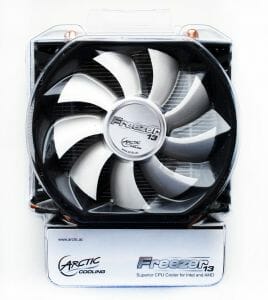
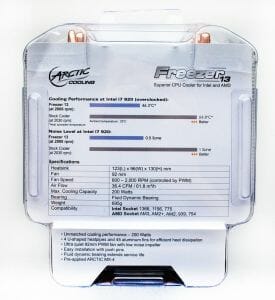
You can see there some information about the cooler’s specs and a couple of diagrams indicating that the Freezer 13 is more effective than a standard boxed Intel cooler by almost 20°C at only half the noise. The manufacturer also claims this cooler can cool CPUs that produce up to 200 watts of heat, which sounds very optimistic.
In the bottom part of the package there is a plastic fastening frame, four locks, two screws, two steel fasteners with screws for AMD CPUs, and an installation guide:
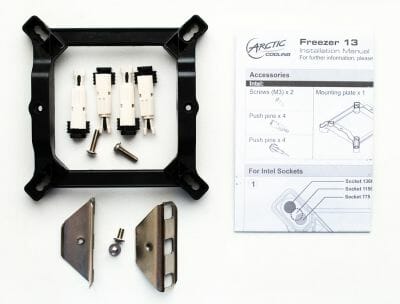
The Arctic Freezer 13 is manufactured in China. Its recommended price is $39.8 and its warranty period is 6 years.
So, this is a tower-design cooler measuring 123x96x130 millimeters at about 700 grams of weight.
The cooler has four copper heat pipes, 6 millimeters in diameter, that go through its copper base. There are 45 aluminum fins, 0.45 millimeters thick and 1.8 millimeters apart, on the pipes. A plastic frame with a fan is attached to one side of the Freezer 13.
You can note that the heatsink is somewhat larger than the 92x92x25mm fan but the air flow is going to be distributed uniformly among the fins thanks to the plastic fan frame and the blank sides of the heatsink. The fins at the bottom of the cooler are smaller, obviously to make it compatible with mainboards that have tall heatsinks on power components near the CPU socket.
The heat pipes do not form a straight line, which is meant to facilitate the uniform distribution of thermal flow from the heat pipes to the fins, but Arctic Cooling might have put the pipes even farther from each other to achieve a stronger effect.
The fins are press-fitted on the heat pipes which lie in grooves and are soldered to the cooler’s base.
The copper plate below the pipes is at least 2.5 millimeters thick. As you can see in the photo, there is already some thermal grease on the cooler’s sole. The manufacturer says this is Arctic MX-4, a high-end thermal interface from Arctic Cooling itself. The amount of grease is so generous that you can remove more than half of it right away. The excess grease will be squeezed out at the edges anyway.
The cooler’s contact spot is 32×30 millimeters large. It is flat but not finished perfectly.
The Arctic Freezer 13 is compatible with all modern platforms including the new LGA1155. The installation procedure is detailed in the included guide. It is in fact very simple. For example, in order to install the cooler on any Intel platform, you first take off the fan frame from the heatsink by unfastening the stiff plastic locks. Then you insert the included plastic frame into the mounting holes in the mainboard and fix it with the included locks.
The cutouts in the frame allow you to move the locks about to adjust them to your mainboard which can be LGA775, 1155, 1156 or 1366. After that you just put the heatsink down on the CPU and fasten it with two screws to the frame. Finally, you attach the frame with fan to the heatsink. That’s all. The symmetrical mounting holes on Intel platforms allow orienting the cooler in any of the four possible ways.
When installing the Freezer 13 on an AMD platform, you use the two included steel plates which are fastened to the cooler’s base and are hitched up to the prongs of the standard plastic frame. In this case, the cooler’s orientation is limited to two positions and will largely depend on the position of the CPU socket on the mainboard.
I’ve mentioned above that the cooler is compact in its bottom part. I can also add that the installed Freezer 13 does not block the first memory slot on the mainboard.
The Arctic Freezer 13 lacks any highlighting but supports PWM-based speed management within a range of 600 to 2000 RPM at a max air flow of 36.4 CFM and a noise level of 0.5 sones. The service life of the fan’s fluid dynamic bearing is not specified but it shouldn’t be shorter than the warranty period of the Freezer 13 itself, which is 6 years.
That’s all I can tell you about the first product. Let’s now take a look at the second one.
Zalman CNPS9900 MAX
The CNPS9900 MAX continues Zalman’s famous series of coolers with radial heatsinks and may even turn out to be its final product. The last cooler with this design that we tested was the Zalman CNPS9900 LED. And that was over two years ago. That cooler didn’t show anything exceptional, so let’s see if the new CNPS9900 MAX can do any better.
It comes in a large and pretty box with a cutout through which you can see some of its heatsink.
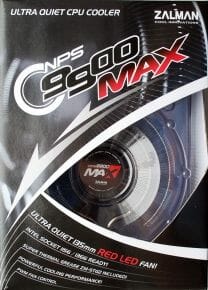
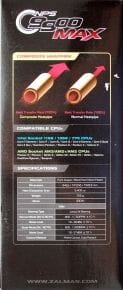
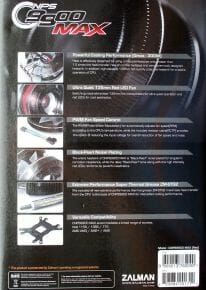
On the other sides of the box you can find product specs and some other information. Besides the cooler, the box contains the following accessories:
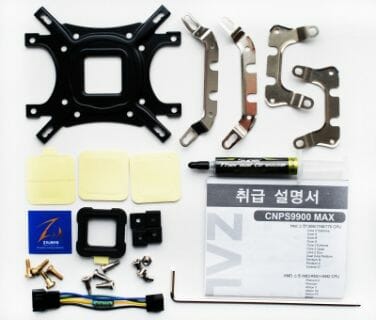
Included into the box is the highly efficient Zalman ZM-STG2 thermal grease (8 W/K·m) that we tested recently.
The Korean firm should be commended for the high-quality product packaging. Besides being fixed within a rather robust plastic shell, the cooler also has a protective plastic ring around its fan and heatsink.
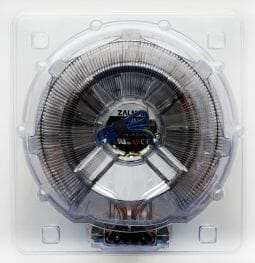
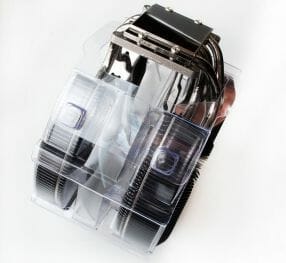
As opposed to most other coolers, the Zalman CNPS9900 MAX is manufactured in Korea rather than China. Its recommended price is $79.9 which is twice the price of the Arctic Freezer 13.
The CNPS9900 MAX hasn’t changed fundamentally in design from its predecessor. It consists of two radial sections with a fan fitted in between.
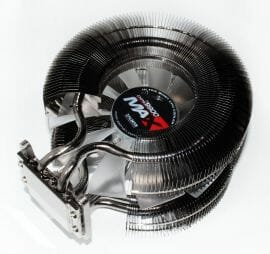
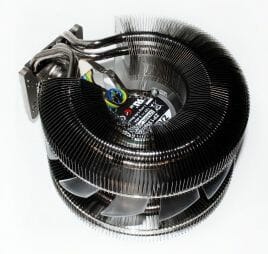
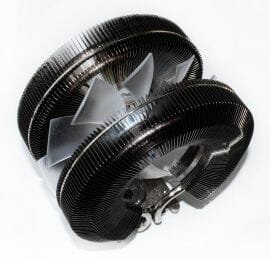
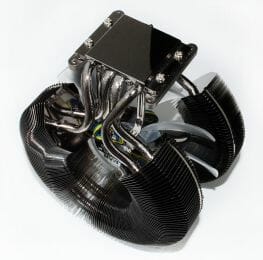
The sections are not covered with a plastic casing as before. And there is now a slim chrome line going along each of them, adding more style to the cooler’s appearance.
Well, the key change is in the type of the heat pipes. The new cooler has composite pipes with a special coating on the inside that facilitates the movement of the evaporated liquid.
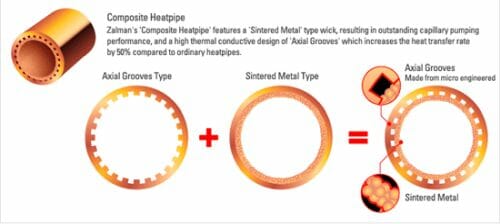
Thus, the heat from the cold end of the heat pipe returns to the hot end along both the capillary channels and that coating. Zalman claims that such pipes are 1.5 times as effective as ordinary ones. That’s good but the CNPS9900 MAX has only three pipes which are but 6 millimeters in diameter, rather than 8 millimeters as we might have expected. Using only three heat pipes in a cooler of such a high class and price doesn’t seem appropriate to me, even though the company claims that the CNPS9900 MAX can cope with CPUs that produce up to 300 watts of heat. Well, we’ll check out its performance shortly.
The size and weight of the CNPS9900 MAX have changed but slightly and are 94x131x152 millimeters and 755 grams. By the way, the weight is rather light for a copper cooler of that size. This must be due to the slim fins which are no thicker than 0.25 millimeters. The fins are 1 to 2.5 millimeters apart from each other.
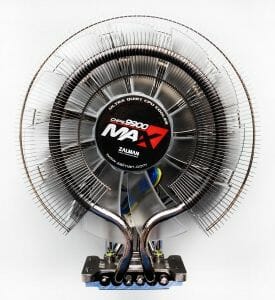
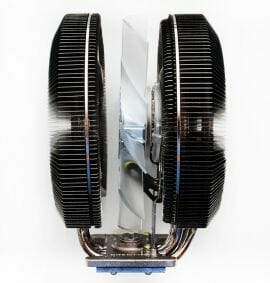
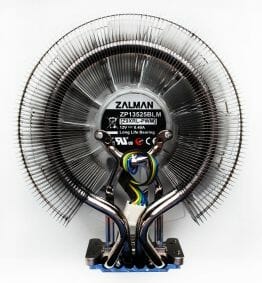
One heatsink section is still thicker than the other and has two pipes rather than one. The two sections are rather far apart from each other, by the way.
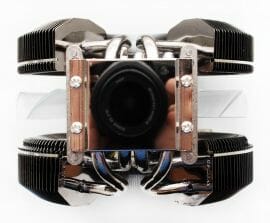
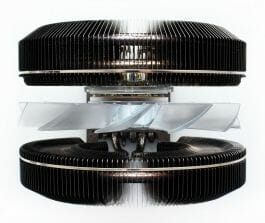
It is clear that the manufacturer might have made the heatsink sections wider to increase their useful area (which is 5402 square centimeters now) or installed a thicker fan for higher efficiency at low speeds and low noise. As you can see, the CNPS9900 MAX implements none of that.
The three heat pipes go out of the cooler’s base and wind around the heatsink and return into the base. Therefore, an inexperienced user might get an impression that the CNPS9900 MAX has six rather than three heat pipes.
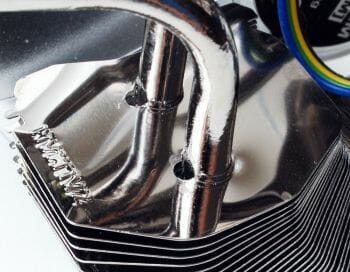
It’s hard to say anything definite about the contact between the fins and the pipes. The marks I can see there resemble some thermal grease rather than solder although soldering would be more efficient, of course.
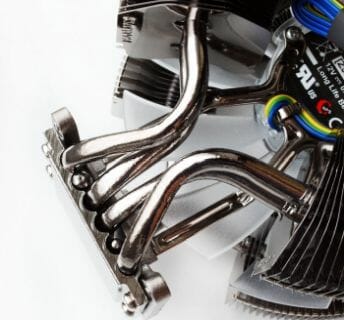
The same goes for the cooler’s base:
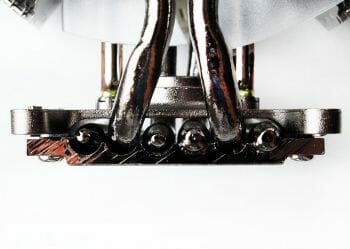
It’s hard to see any marks of solder in the places of contact between the heat pipes and the base because the heatsink and the pipes are all nickel-plated.
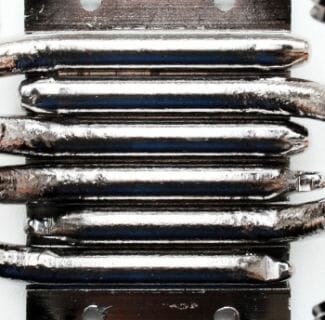
But I can say it quite definitely that the base of my CNPS9900 MAX is not flat. It is curved along and across the base:
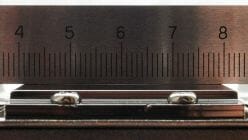
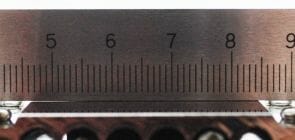
However, the high pressure and the convex surface of my six-core Intel processor resulted in a satisfactory imprint of thermal grease on the cooler:
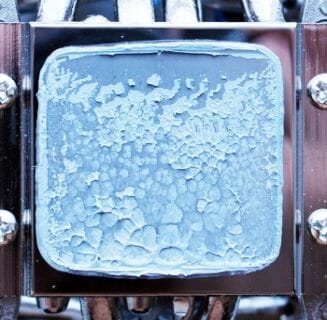
By the way, although not ideally flat, the 40x38mm base is finished perfectly:
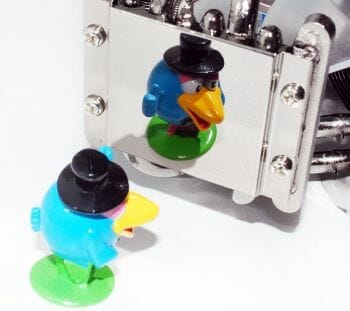
The Zalman CNPS9900 MAX is equipped with a large 11-blade 130mm impeller although Zalman’s specs mention a 135mm fan (the ZP13525BLM model):
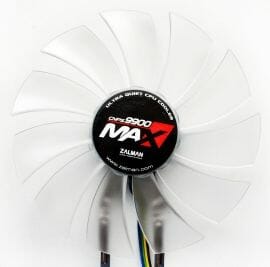
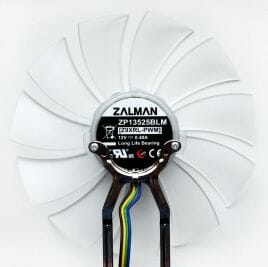
It is fastened on two pins attached to the top of the cooler’s base. The speed of the fan is PWM controlled in two ranges. If the cooler is connected to a mainboard directly, the fan speed is going to be in a range of 900 to 1700 RPM at 18 to 30 dBA of noise. And if you connect the included resistor to the fan, the top speed limit lowers to 1500 RPM (27 dBA) while the bottom limit remains the same. This is a rather odd choice of speeds because the cooler is going to be noisy in both cases. I would prefer the resistor variant to reduce the speed range to 600-1100 RPM, for example.
Such parameters as air flow, static pressure and the service life of the ball bearing are not specified.
The Zalman CNPS9900 MAX comes with two types of highlighting: blue and red.
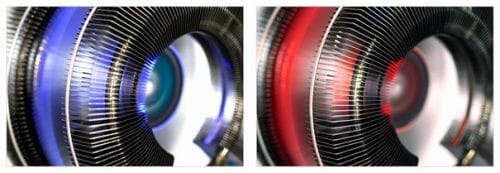
The color is indicated on the product box.
The Zalman CNPS9900 MAX is compatible with all modern PC platforms. The user guide details its installation procedure which is actually the same as with the Zalman CNPS10X Flex we tested earlier. The cooler is fastened to the mainboard with a back-plate that has detachable tips.
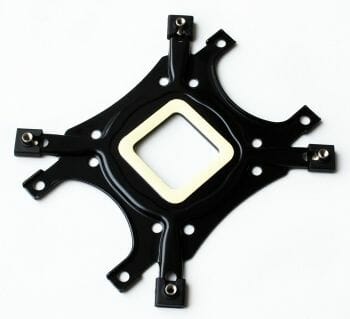
You should also attach the type of fasteners to the cooler’s base that match your platform: AMD (on the left) or Intel (on the right).
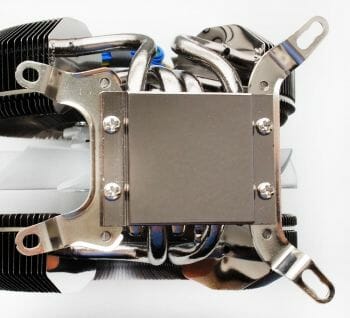
The cooler is then put on the CPU and fastened to the back-plate with four screws using a hex-head L-shaped key.
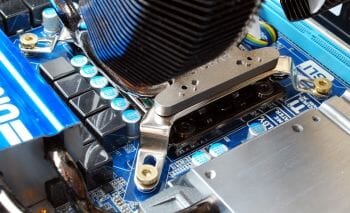
The pressure is very high: the steel feet of the fastening mechanism bend, almost touching the surface of the mainboard.
When installed into a system case, the Zalman CNPS9900 MAX looks quite original and pretty:
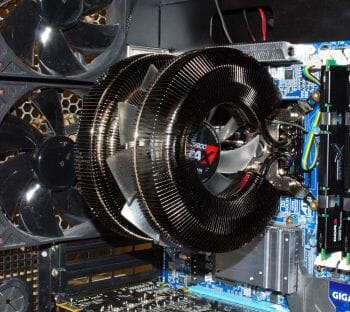
Its efficiency does not depend on its orientation as I found out during a brief preliminary test, so for the main test I positioned it in such a way that its air flow was directed towards the back panel of the system case.
Testbed and Methods
We performed all cooler tests inside a system case with a removed side panel. Here is our testbed configuration:
- Mainboard: Gigabyte GA-X58-UD9 (Intel X58 Express, LGA 1366, BIOS F5i);
- Processor: Intel Core i7-980X Extreme Edition, 3.33 GHz, 1.225 V, 6 x 256 KB L2, 12 MB L3 (Gulftown, B1);
- Thermal interface: Gelid GX-Extreme;
- Graphics card: ATI Radeon HD 5770 1 GB GDDR5 128 bit, 850/4800 MHz;
- Memory: DDR3 3 x 2 GB OCZ Platinum Low-Voltage Triple Channel (Spec: 1600MHz / 7-7-7-24 / 1.65 V);
- System drive: RAID-0 of 2 x Kingston V-series SNV425S2128GB SSD (SATA-II, 128 GB, MLC, Toshiba TC58NCF618G3T controller);
- Drive for programs and games: Western Digital VelociRaptor (300GB, SATA-II, 10000 RPM, 16MB cache, NCQ) inside Scythe Quiet Drive 3.5” HDD silencer and cooler;
- Backup drive: Samsung Ecogreen F4 HD204UI (SATA-II, 2 TB, 5400 RPM, 32 MB, NCQ);
- System case: Antec Twelve Hundred (front panel: three Noiseblocker NB-Multiframe S-Series MF12-S2 fans at 900 RPM; back panel: two Noiseblocker NB-BlackSilentPRO PL-1 fans at 900 RPM; top panel: standard 200 mm fan at 400 RPM; side panel removed);
- Control and monitoring panel: Zalman ZM-MFC2;
- Power supply: Zalman ZM1000-HP 1000 W (with a default 140 mm fan).
We overclocked our six-core processor (with its default non-lapped heat-spreader) with the multiplier set at 25x and “Load-Line Calibration” (Level 2) enabled to the modest 4.2 GHz. The nominal processor Vcore was increased to 1.35625 V in the mainboard BIOS.
Turbo Boost and Hyper-Threading technologies were disabled during our test session. The memory voltage was at 1.64 V and its frequency was 1.4 GHz (8-8-8-18_1T timings). All other parameters available in the mainboard BIOS and related to CPU or memory overclocking remained unchanged.
All tests were performed under Windows 7 Ultimate x64 operating system. We used the following software during our test session:
- CPU Stress Test (CST) version 0.18b – to load the processor (matrix # 15, 10-12 minutes);
- Real Temp GT 3.59 – to monitor the processor core temperature;
- CPU-Tweaker 1.5 – to visually monitor temperatures and frequencies using graphics.
We replaced the Linpack x64 test in LinX shell we have been using before with the CPU Stress Test (CST) program for a very simple reason: the new program heats up our six-core processor even more (2-3°C more) than Linpack, generates more linear load and has significantly shorter intervals between the CST runs than between Linpack cycles.
The CPU was loaded with two consecutive Linpack x64 test runs with the settings as indicated above. The stabilization period for the CPU temperature between the two test cycles was about 8-10 minutes. We took the maximum temperature of the hottest CPU core for the results charts. Moreover, we will also provide a table with the temperature readings for all cores including their average values. The ambient temperature was checked next to the system case with an electronic thermometer with 0.1 °C precision that allows hourly monitoring of the temperature changes over the past 6 hours. The room temperature during our test session varied between the annoying 23.9-24.4 °C.
The noise level of each cooler was measured between 1:00 and 3:00 AM in a closed room about 20 m2 big using CENTER-321 electronic noise meter. The noise level for each cooler was tested outside the system case when the only noise sources in the lab were the cooler and its fan. The noise meter was installed on a tripod and was always at a 150 mm distance from the cooler fan rotor. The tested cooling systems were placed at the edge of the desk on a sheet of polyurethane foam. The lowest noise reading our noise meter device can register is 29.8 dBA and the subjectively comfortable noise level in these testing conditions was around 35 dBA (do not mix it up with low noise level). The fan(s) rotation speed was adjusted in the entire supported range using the new controller revision by changing the voltage with 0.5 V increment.
We are going to compare our today’s testing participants against Zalman CNPS10X Performa and Thermalright Archon in their standard configuration with one fan.
The first one sells at the same price as Arctic Freezer 13 and the second one – at the price of Zalman CNPS9900 MAX, so the comparison promises to be very interesting.
Cooling Efficiency
Before getting right to the main tests, I want to show you some other results. Our readers have asked that we perform our cooler tests without overclocking our CPU since overclockers are but a small share of PC users. So, I performed such this kind of a test using four coolers. Here are the results.
Although I didn’t overclock it and turned off Hyper-Threading technology, the six-core Intel processor proves to be able to show us the difference between the coolers. However, the temperature of the hottest CPU core is no higher than 70°C even with the worst cooler which is the Arctic Freezer 13 at 1200 RPM. When used in the PWM mode, the cooler becomes 5°C more efficient, yet still inferior to the more expensive Zalman CNPS9900 MAX at 1010 RPM. The difference is about 2°C.
The Zalman CNPS9900 MAX, in its turn, is 3°C worse than its cousin CNPS10X Performa at a rather quiet speed of 1020 RPM but beats the latter in the PWM mode at the max speed of 1530 RPM. The Zalman CNPS10X Performa at max speed outperforms the CNPS9900 MAX by 3°C, though. The Thermalright Archon, even though somewhat insulted at having to cool a non-overclocked CPU, outperformed the rest of the coolers in terms of CPU temperature as well as noise because the max speed of its default Thermalright TY-140 fan is only 1290-1300 RPM.
Next, let’s see how good the coolers are when the CPU is overclocked to 4.2 GHz.
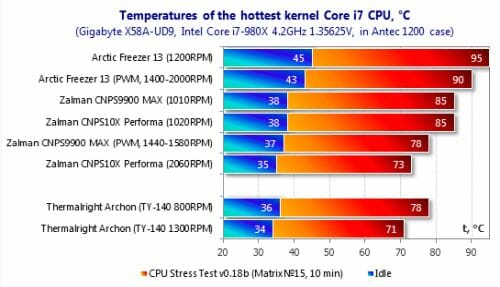
The differences between the coolers are now clearer. We can see that the Arctic Freezer 13 in the quiet mode (1200 RPM) can but barely cope with the 4.2GHz six-core CPU but lowers the temperature by 5°C in the PWM mode. In fact, this is the maximum overclocking limit for the new Swiss cooler.
Working at 1010 RPM, the Zalman CNPS9900 MAX was 2°C better than the Freezer 13 with the non-overclocked CPU and is now 5°C better when the CPU is overclocked. Interestingly, it is also now as good as the Zalman CNPS10X Performa at 1020 RPM. When the PWM control is enabled, the Zalman CNPS9900 MAX lowers the temperature of the hottest CPU core by 7°C, which is quite good for a 580RPM increase in speed. On the other hand, the CNPS10X Performa can lower that temperature by as much as 12°? when working at its full speed (+1040 RPM) and get ahead of the CNPS9900 MAX by 5°C. The tower-design cooler is louder then, of course.
So if you want less noise, you should take a look at the Thermalright Archon with its large and high-quality TY-140 fan. Take note of the large difference in the performance of this cooler at 800 RPM and maximum speed when cooling the overclocked CPU. It amounts to 9°C. Anyway, the Archon proves its superiority even though the CPU is still not hot enough for this super-cooler to show its best.
I can add to these results that I could overclock my six-core CPU with the Zalman CNPS9900 MAX cooler at 1740 RPM to a clock rate of 4.37 GHz with a voltage of 1.425 volts. The maximum temperature of the hottest CPU core was 89°C then.
As we see, Zalman CNPS10X Performa with its default fan running at 2060 RPM cools the CPU better by 8°C…and the Thermalright Archon is as much as 13°C better using one TY-140 fan at 1300 RPM.
So, the Zalman CNPS9900 MAX is quite good in itself. Its predecessor CNPS9900 LED of the same design could not deliver such performance. Of course, the price factor should also be taken into account as I will do in the Conclusion. Right now let’s see how much noise the coolers produce.
Acoustic Performance
Compared to the Thermalright TY-140, the fans of the three other coolers perform quite well. Of course, the two new products and the Zalman CNPS10X Performa are inferior to the Thermalright Archon in terms of maximum noise, but the Arctic Freezer is competitive up to 1800 RPM, the CNPS9900 MAX up to 1350 RPM and the CNPS10X Performa, which has a nonlinear correlation between noise and speed, remains competitive to the leader up to a fan speed of 1450 RPM.
When we talk about the comfortable level of noise, the speeds are lower, of course. It is 1480 RPM for the Arctic Freezer 13, about 1000 RPM for the Zalman CNPS9900 MAX and about 1070 RPM for the Zalman CNPS10X Performa. Subjectively, the 92mm fan of the Arctic Freezer 13 is the most agreeable to the ear among the four. It can increase its speed smoothly, without any rattle, vibrations or anything. The fan of the CNPS9900 MAX is good, too. Despite its large diameter and the fastening system that might arouse one’s apprehensions, it does not produce any unwanted sounds, either. You can only hear the flow of the air as it is being pumped with the impeller’s 11 blades.
Conclusion
Cutting it short, there are now two more CPU coolers available. The new products can hardly be of interest to extreme enthusiasts and definitely do not suit much for people who assemble quiet computers. Anyway, they sell already and that’s what they offer.
The Arctic Freezer 13 is a $39.80 cooler that has a simple multiplatform fastening mechanism which allows installing it without taking the mainboard out of the system case. It is compact, supports PWM-based fan speed control, has a rather low level of noise and average efficiency, and comes with Arctic MX-4 thermal grease.
The larger Zalman CNPS9900 MAX is twice as expensive as the Arctic Freezer 13. It has a multiplatform fastening mechanism, too. Besides an original exterior design and pretty highlighting, it delivers good performance at a moderate level of noise. This cooler might be made more effective with certain improvements but the Korean company will hardly develop this product line any further. Judging by the name of the product, they think they have reached the maximum of its potential.